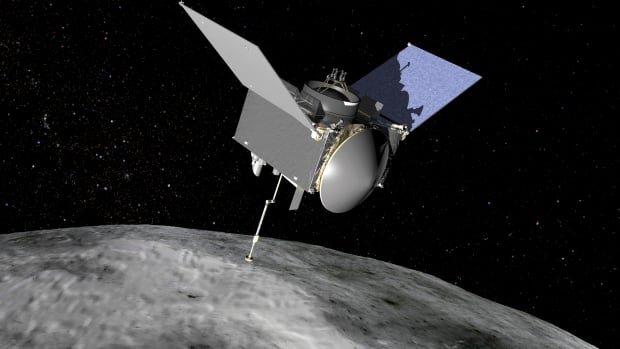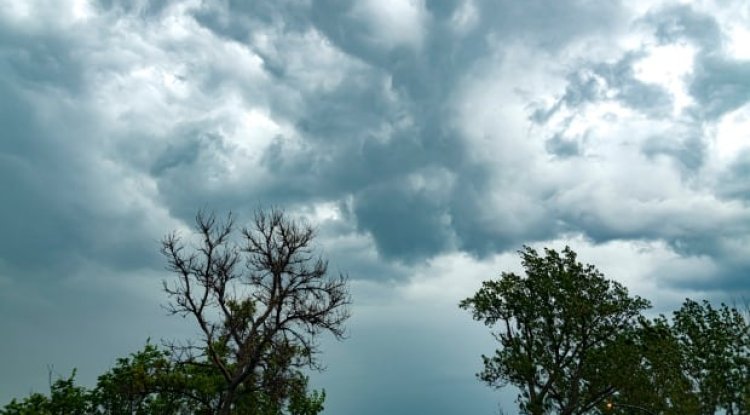Spacecraft drops cargo to Earth after plucking material from asteroid
Here is an artist's rendering of the Origins, Spectral Interpretation, Resource Identification, Security-Regolith Explorer (OSIRIS-REx) spacecraft. (NASA/Reuters)A space capsule that grabbed rare fragments from the asteroid Bennu came to a "stable rest" in the Utah desert on Sunday, touching down after a mission that began seven years ago, NASA said.The capsule smoothly descended with a parachute to its landing zone about four hours after the OSIRIS-REx spacecraft travelled past Earth and released the cargo. Scientists estimate the capsule holds at least a cup of rubble, or about 250 grams, from the carbon-rich asteroid, Bennu, but won't know for sure until the container is opened. Some spilled and floated away when the spacecraft scooped up too much and rocks jammed the container's lid during collection three years ago.OSIRIS-REx had travelled to a crater in the asteroid's northern hemisphere in 2016 and reached it two years later. Once there, it lowered a robotic arm vacuum into the

A space capsule that grabbed rare fragments from the asteroid Bennu came to a "stable rest" in the Utah desert on Sunday, touching down after a mission that began seven years ago, NASA said.
The capsule smoothly descended with a parachute to its landing zone about four hours after the OSIRIS-REx spacecraft travelled past Earth and released the cargo.
Scientists estimate the capsule holds at least a cup of rubble, or about 250 grams, from the carbon-rich asteroid, Bennu, but won't know for sure until the container is opened. Some spilled and floated away when the spacecraft scooped up too much and rocks jammed the container's lid during collection three years ago.
OSIRIS-REx had travelled to a crater in the asteroid's northern hemisphere in 2016 and reached it two years later. Once there, it lowered a robotic arm vacuum into the surface to extract the third and largest sample ever taken from an asteroid in the first mission of its kind for NASA.
Canada had an important role to play, providing an instrument called the OSIRIS-REx Laser Altimeter (OLA), which scanned and measured the surface of the 500-metre-wide asteroid, creating a 3D model that helped mission planners decide where to land.
Science adviser to the president of the Canadian Space Agency John Moores said the contribution means scientists in Canada will have access to a small portion of the asteroid material.
"In total, we laid down more than three billion measurements … so this now provides a very highly precise map of the asteroid," said Cameron Dickinson, a staff engineer at Canadian space company MDA Ltd., which designed the Canadian component of the spacecraft.
Japan will also get some of the bounty, after returning to Earth with much smaller samples — about a teaspoon of rubble — from two other asteroids in 2010 and 2020, giving NASA a portion each time.

2-year analysis
The capsule that sucked up loose rocks and pebbles for NASA landed after a journey home of nearly two billion kilometres.
NASA deployed a team, equipped with helicopters, to recover the capsule from the desert and will transport it to a temporary clean room set up at the U.S. Defense Department's Utah Test and Training Range.
It's estimated the recovery team will need a day to take the capsule apart and prepare the sample for transport to a new lab at NASA's Johnson Space Centre in Houston, where a two-year analysis will take place. The sample will be revealed to the public on Oct. 11.

The mission's lead scientist, Dante Lauretta of the University of Arizona, will accompany the sample to Texas. The opening of the container in Houston in the next day or two will be "the real moment of truth," given the uncertainty over the amount inside, he said ahead of the landing.
Bennu, discovered in 1999, is classified as a "near-Earth object" because it passes relatively close to our planet every six years. It measures about half a kilometre across and is roughly the size of the Empire State building.
The asteroid is expected to come dangerously close to Earth in 2182 — possibly close enough to hit. The data gleaned by OSIRIS-REx will help with any asteroid-deflection effort, according to Lauretta.

Tim Haltigin, planetary senior mission scientist with the Canadian Space Agency, has worked on the project for a decade. Asteroids, he said, are leftover ingredients from the formation of the solar system, and getting a sample from one "is sort of like going back into a cosmic mixing bowl and pulling out individual grains of sugar and a bit of flour and, you know, maybe a chocolate chip."
"And so this is how we're able to study the raw ingredients of the solar system as they were billions and billions and billions of years ago," Haltigin said.
Now free of the sample capsule, OSIRIS-REx is already targeting the asteroid Apophis for an encounter scheduled for 2029, when the space rock will make its closest known flyby of Earth.
What's Your Reaction?

















